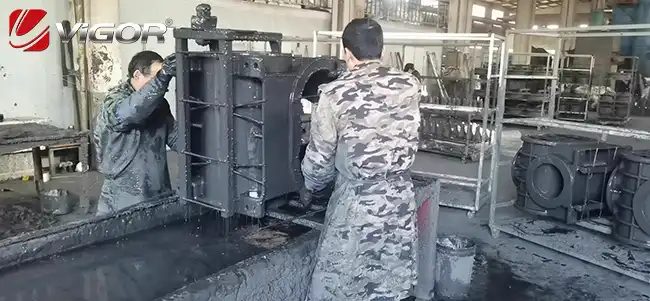
Knowledge
What Is the Process of Lost-Foam Casting?
1. Use Foam Molds for Foam Pattern and Gating System Production
In lost-foam casting, foam patterns mimic the precise geometry of the finished metal object. The gating system has passages that direct molten metal into the mold and may be integrated into the foam pattern or attached (glued on) later. These passages enable precise designs and streamlined metal flow, resulting in castings that are accurate and effective.
2. Bond Patterns and Runners To Create a Mold Bundle Module
Tightly bind the foam patterns and gating mechanisms to form the mold bundle module prior to casting. This assembly makes the casting process easier by ensuring precise component alignment, reducing mistakes, and facilitating reliable, consistent manufacture of complex metal parts.
3. Apply Dip Paint and Allow the Paint To Dry
An application of refractory dip paint follows the assembly of the mold bundle module. When this paint dries, it creates a protective ceramic coating that improves the mold's surface toughness, heat resistance, and capacity to handle the temperature and pressure of the molten metal.
4. Place the Module in a Sandbox and Fill It With Dry Sand
Coat the mold bundle module, set it within a molding flask, and cover it in dry sand. This phase ensures accurate replication of the desired metal part by supporting the module's shape, keeping it in place during casting, and facilitating uniform sand compaction.
5. Vibrate Molding To Fill the Cavity and Compact the Sand
Sand may now flow into every nook and cranny of the mold bundle module thanks to vibrations imparted to the molding flask. Through careful sand compaction and the elimination of air spaces, this procedure enables the creation of a high-quality casting with exact measurements and fine details.
6. Pour Molten Metal To Vaporize the Foam and Create Desired Castings
Carefully pour the molten metal into the mold, replacing the vaporized foam patterns. The metal solidifies to create the desired casting as it fills the spaces the foam left behind. As a result, the finished product closely resembles the planned form while minimizing flaws and blemishes. This technique supports complicated and complex shapes.
7. Clean the Castings After They Have Cooled
After the castings have cooled and set, clean the casting to get rid of any remaining sand, ceramic shells, and other impurities. To produce high-quality and aesthetically pleasing metal parts, this phase means that the final castings fulfill quality requirements, have smooth surfaces, and are ready for subsequent finishing procedures or assembly.
The lost-foam casting process significantly lowers labor requirements and waste production. It is also possible to recycle used dry sand, which is in line with objectives for lowering emissions and using less energy.
As a leading machinery and equipment manufacturer, Vigor offers a wide range of casting processes tailored to meet your specific product requirements. Upon completion of production, we conduct comprehensive 100% testing in accordance with customer specifications and industry standards, ensuring that the product quality aligns with the exact needs of our clients. If you are considering Vigor's mechanical products, we encourage you to reach out to us without delay to access top-notch technical service and the highest quality products available.




